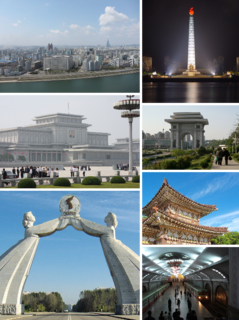
Pyongyang is the capital and largest city of North Korea, where it is known as the "Capital of the Revolution". Pyongyang is located on the Taedong River about 109 km upstream from its mouth on the Yellow Sea. According to the 2008 population census, it has a population of 3,255,288. Pyongyang is a directly-administered city with equal status to North Korean provinces.

South Pyongan Province is a province of North Korea. The province was formed in 1896 from the southern half of the former Pyongan Province, remained a province of Korea until 1945, then became a province of North Korea. Its capital is Pyongsong.
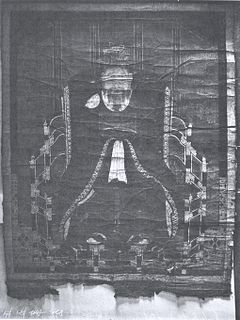
Gongmin of Goryeo, born Wang Gi, later changed his name to Wang Jeon, ruled Goryeo Korea from 1351 to 1374. He was the second son of King Chungsuk. He was sometimes known by his Mongolian name, Bayan Temür, which was rendered in hanja as Baek'ancheopmok'a.

The Mount Myohyang is a mountain in North Korea. It is named after the mystic shapes and fragrances found in the area. It is a sacred site as, according to legend, it was the home of King Tangun, forefather of the Korean people.

Takuan, or takuan-zuke, known as danmuji (단무지) in the context of Korean cuisine, is a pickled preparation of daikon radish. As a popular part of traditional Japanese cuisine, takuan is often served uncooked alongside other types of tsukemono. It is also enjoyed at the end of meals as it is thought to aid digestion.
Oseam or Oseam Temple is a small Korean Buddhist temple located in the area of Mangyeongdae Pavilion, Mount Seorak, Gangwon Province, South Korea. It is an annex of Baekdamsa Temple which is the head temple of the third district in the Jogye Order.

Chengde Puning Airport is an airport serving the city of Chengde in Hebei Province, North China. It is located 19.5 kilometres (12.1 mi) northeast of the city center in Tougou Town, Chengde County. Construction began on March 25, 2011 at an estimated cost of 1.5 billion yuan. The airport was opened on May 31, 2017.
Song Deok-Gi ; was a Martial artist from Korea. One of the last practionners of the ancient martial art of Taekkyon, he helped convey the art during the Japanese Occupation of Korea (1910-1945) and the Korean War (1950-1953). Based on his efforts, the South Korean government acknowledged Taekkyon as the 76th Important Intangible Cultural Properties of Korea and recognized him as a Human Cultural Asset (Ingan-munhwage). He used Hyeonam as a pen name.

Cho-ui Seonsa (1786–1866) is often called "The Saint of Korean Tea" or the "Father of Korean Tea". He was a Korean Buddhist Seon (Zen) Master who in the first half of the 19th century introduced the Way of Tea and the practices of Buddhism to many aristocratic scholars who were dissatisfied with the rigid neo-Confucianism of the Joseon era. He was himself noted as a calligrapher and artist, as well as a poet, and he formed deep friendships with other famous figures of his time, especially Jeong Yak-yong and Kim Jeong-hui.
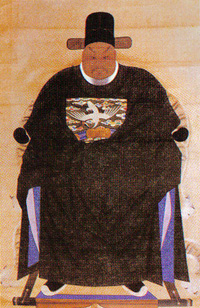
Gim Seokju was one of the Neo-Confucian scholars, politicians and writers of the Korean Joseon Dynasty. His nickname was Sigam, a courtesy name was Sabaek. He was a cousin of Queen Myunseong. He was prime minister of the Joseon Dynasty in 1680.
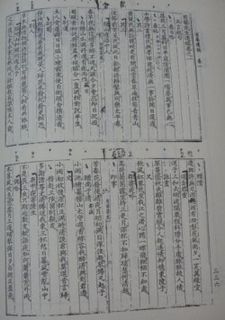
Kim Hyo-won was a Korean Joseon Dynasty politician, writer, and Neo-Confucian scholar. His pen name was Seongam, and his courtesy name was Inbaek. He was also a leader of the Easterners faction. Kim was from the Seonsan Kim clan.
Jeong In-hong was a Korean politician, Neo-Confucian scholar, general, and leader of the Northerners faction. He served as Prime Minister or Chief State Councillor during the reign of Gwanghaegun. His pen name was Raeam. He belonged to the Seosan Jeong clan.

The Bishan Temple or Guangji Maopeng is a Buddhist temple located in Taihuai Town of Wutai County, Xinzhou, Shanxi, China.
Tiantai Temple, also known as the Temple of Ksitigarbha (地藏寺), is the highest Buddhist temple located on Mount Jiuhua, in Qingyang County, Anhui, China. It was first built in the Tang dynasty (618–907), and went through many changes and repairs through the following dynasties. Most of the present structures in the temple were repaired or built in the late Qing dynasty (1644–1911).
Depot Road is a subzone within the planning area of Bukit Merah, Singapore, as defined by the Urban Redevelopment Authority (URA). Its boundary is made up of the Ayer Rajah Expressway (AYE) in the north; Alexandra Road in the west; Depot Road in the south; and Henderson Road in the east.
Prince Deokheung, — personal name Wang Hye — was the son of Chungseon of Goryeo and a Mongolian-backed pretender to the throne of Goryeo. He was also known by his Mongolian name, Tash-Temür or sometimes spelled as Tapsacheopmoka (탑사첩목아) in Sino-Korean. The Yuan dynasty, under the influence of Empress Gi, attempted to dethrone Goryeo's king, Gongmin, and install Prince Deokheung as the new king. In 1364, a Yuan army, under the command of General Choe Yu (崔濡), attempted to invade Goryeo but failed in its objective to dethrone King Gongmin. He was also a Korean Buddhist monk. There was no records left about his mother.
Kim Ha-jong(김하종, 金夏鐘), 1793–after 1875, was a Joseon court painter. His ho was Yudang, 유당, 蕤堂. He is known for the Album of Sea and Mountains, which contains 25 paintings, each of them is 29.7×43.3cm. This work was painted in 1815, at the request of Yi Gwangmun (1778–1838), who wrote the colophon of the Album.
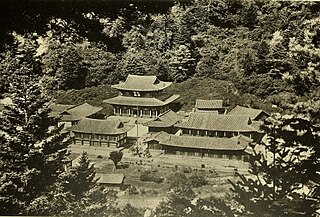
Jangansa was a Korean Buddhist temple on Mount Geumgang (금강산,金剛山).










